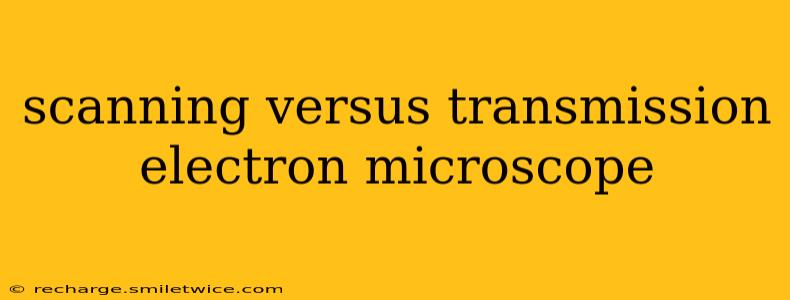Electron microscopy is a powerful technique used to visualize structures at the nanoscale, far beyond the capabilities of traditional light microscopy. Two primary types dominate the field: Scanning Electron Microscopes (SEM) and Transmission Electron Microscopes (TEM). While both utilize electrons to create images, they do so in fundamentally different ways, resulting in distinct applications and image characteristics. This detailed comparison will explore the key differences, highlighting their strengths and limitations.
What is a Scanning Electron Microscope (SEM)?
A Scanning Electron Microscope uses a focused beam of electrons to scan the surface of a sample. As the beam interacts with the sample's surface, it causes the emission of secondary electrons, backscattered electrons, and X-rays. These signals are detected and used to create a high-resolution image representing the sample's topography and composition. SEMs excel at providing detailed three-dimensional images of surfaces, making them invaluable for analyzing textures, shapes, and surface features.
Advantages of SEM:
- High-resolution imaging of surface features: Provides incredibly detailed, three-dimensional images of surface topography.
- Large depth of field: Allows for the visualization of samples with significant height variations in sharp focus.
- Sample preparation is relatively straightforward: Often requires less extensive sample preparation compared to TEM.
- Versatile imaging modes: Can utilize various detectors to acquire different types of information, including elemental composition (EDS).
Disadvantages of SEM:
- Lower resolution compared to TEM: While high-resolution, SEM images aren't as high-resolution as those produced by TEM.
- Limited penetration depth: Primarily visualizes surface features; internal structures are not readily observed.
- Vacuum environment required: Samples must be placed in a vacuum chamber, which can limit the types of samples that can be analyzed.
- Electron beam damage: The high-energy electron beam can damage sensitive samples.
What is a Transmission Electron Microscope (TEM)?
A Transmission Electron Microscope transmits a high-energy electron beam through an ultra-thin sample. As the electrons pass through, they interact with the sample's internal structure, leading to scattering or diffraction. The resulting pattern is projected onto a screen or detector, generating a high-resolution image of the sample's internal structure. TEMs are unmatched in their ability to visualize fine details within materials, making them essential for studying cellular structures, crystal lattices, and nanoscale materials.
Advantages of TEM:
- Extremely high resolution: Provides the highest resolution of any microscopy technique, capable of resolving individual atoms in some cases.
- Visualizes internal structures: Allows for the detailed observation of internal structures and features not visible using SEM.
- Crystalline structure analysis: Can be used to determine the crystalline structure of materials through electron diffraction.
- Versatile sample preparation techniques: While demanding, advanced sample preparation techniques allow for the study of a wide range of materials.
Disadvantages of TEM:
- Requires extremely thin samples: Sample preparation is often complex and time-consuming, requiring ultrathin sections (nanometers in thickness).
- High vacuum environment required: Similar to SEM, the analysis must be conducted under high vacuum.
- High cost and maintenance: TEMs are expensive to purchase and maintain.
- Electron beam damage: The high-energy electron beam can damage sensitive samples.
What are the key differences between SEM and TEM?
| Feature | SEM | TEM |
|---|---|---|
| Electron beam | Scans the sample surface | Transmits through the sample |
| Image type | Surface topography, composition | Internal structure, crystallographic data |
| Sample prep | Relatively simple | Complex, requires ultrathin sections |
| Resolution | High, but lower than TEM | Extremely high |
| Depth of field | High | Low |
| Applications | Material science, biology, geology | Materials science, biology, nanotechnology |
What type of microscope is best for my research?
The choice between SEM and TEM depends entirely on the research question and the nature of the sample being investigated. If you need to visualize the surface topography and composition of a relatively thick sample, SEM is likely the better option. However, if high-resolution imaging of internal structures or crystallographic information is essential, then TEM is the superior choice. In some cases, both techniques might be used in combination to obtain a comprehensive understanding of the sample.
What are the limitations of electron microscopy?
Both SEM and TEM have inherent limitations. The requirement for a high-vacuum environment restricts the analysis of hydrated or volatile samples. The high-energy electron beam can induce sample damage, particularly in sensitive biological specimens. Finally, sample preparation can be technically challenging and time-consuming, especially for TEM.
How do I choose between SEM and TEM for my research?
Consider the following factors:
- The nature of your sample: Is your sample thick or thin? Are you interested in surface features or internal structures?
- The resolution required: Do you need the highest possible resolution, or is a high-resolution image sufficient?
- The type of information you need: Are you interested in topography, composition, or crystal structure?
- Your budget and resources: TEMs are significantly more expensive than SEMs to purchase and maintain.
By carefully considering these factors, researchers can choose the most appropriate electron microscopy technique for their specific needs.
